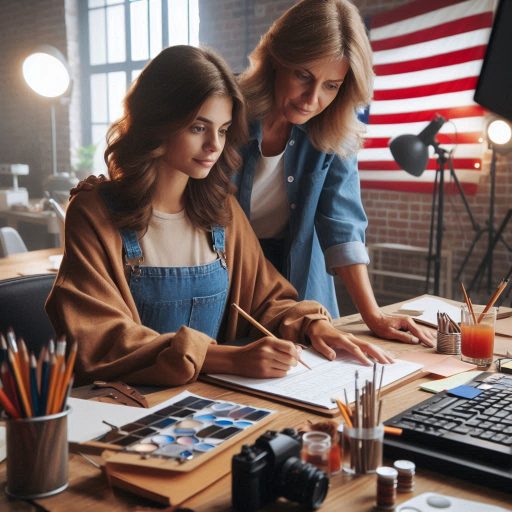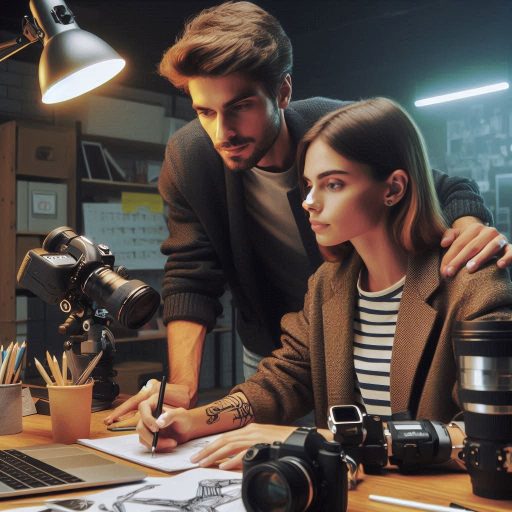Introduction
Importance of Tools and Software for Modern Set Designers
Tools and software are essential for modern set designers.
They enhance creativity, streamline workflows, and improve collaboration among teams.
With the right resources, designers can efficiently bring their visions to life.
Technological Advancements in Set Design
Technological advancements have revolutionized the set design industry.
Designers now use 3D modeling software to create accurate and detailed representations of their ideas.
Programs like SketchUp and AutoCAD allow for precise measurements and adjustments.
Virtual reality (VR) technology enables designers to immerse themselves in their creations before production.
This innovation enhances the design process and helps identify potential issues early.
Aim of the Blog Post
This blog post aims to provide a comprehensive guide on essential tools and software for modern set designers.
We will explore popular design programs, collaboration platforms, and visualization tools.
By outlining these resources, we will help aspiring and established designers choose the best tools for their projects.
Understanding and utilizing these technologies can significantly improve design quality and efficiency.
Designers can create stunning environments that captivate audiences while meeting production demands.
3D Modeling Software
The Significance of 3D Modeling Software
3D modeling software has transformed set design by allowing designers to create realistic and detailed environments.
With these tools, designers can visualize their concepts in three dimensions.
This capability enhances communication with directors and producers, enabling clearer discussions about the final vision.
Moreover, 3D modeling software helps designers experiment with various elements easily.
They can adjust lighting, textures, and colors to see how different choices impact the overall design.
This iterative process saves time and resources by allowing for revisions before construction begins.
Additionally, designers can create accurate scale models of their sets.
These models help identify potential issues in design or functionality.
By addressing these challenges in the digital realm, designers can streamline the construction process and avoid costly mistakes on set.
Popular 3D Modeling Software for Set Designers
Several 3D modeling software options have gained popularity among set designers.
Three of the most widely used are AutoCAD, SketchUp, and Blender.
Each offers unique features tailored to different aspects of the design process.
AutoCAD
AutoCAD is a powerful software known for its precision and versatility.
It allows designers to create detailed 2D and 3D drawings with ease.
Set designers appreciate its extensive library of architectural components, which can expedite the design process.
One key feature of AutoCAD is its ability to create dynamic blocks.
Designers can reuse and modify these blocks, saving time on repetitive tasks.
AutoCAD also supports collaboration through cloud storage, enabling team members to work on projects simultaneously.
SketchUp
SketchUp is favored for its user-friendly interface and intuitive design tools.
It allows designers to create 3D models quickly and efficiently.
The software‘s drag-and-drop functionality makes it accessible for beginners and experienced designers alike.
A standout feature of SketchUp is its extensive 3D Warehouse, where users can find and share models.
This resource provides ready-made elements that designers can incorporate into their projects.
SketchUp also supports various plugins, enhancing its functionality for specific design needs.
Blender
Blender is a free, open-source software that offers advanced 3D modeling capabilities.
It is known for its powerful rendering engine and animation tools.
Set designers use Blender to create highly detailed models and visually stunning presentations.
One of Blender’s key features is its ability to simulate realistic lighting and materials.
This capability allows designers to visualize how a set will appear on screen or stage.
Additionally, Blender’s sculpting tools enable designers to create intricate details, enhancing the overall design quality.
Benefits of 3D Modeling Software for Set Designers
In summary, 3D modeling software significantly enhances the set design process.
It allows for realistic visualization, efficient experimentation, and accurate modeling.
Tools like AutoCAD, SketchUp, and Blender each offer unique features that cater to different design needs.
By utilizing these software options, set designers can elevate their creative visions and streamline their workflows.
Embracing these tools is essential for success in the modern design landscape.
Read: Freelance Character Design: How to Get Started
Virtual Reality Tools
How Virtual Reality Tools Allow Set Designers to Visualize Their Designs
Virtual reality (VR) tools revolutionize the way set designers visualize their creations.
These innovative technologies provide immersive environments where designers can interact with their designs.
By using VR, set designers can experience their spaces as if they were physically present.
This capability enhances their understanding of scale, depth, and spatial relationships.
Designers can manipulate elements within the virtual space in real-time.
This interaction allows for immediate adjustments based on instinct and intuition.
VR tools make it easier to explore different configurations and layouts without the need for physical prototypes.
Designers can test various color schemes, lighting effects, and materials quickly and efficiently.
Popular VR Tools Like Oculus Rift and HTC Vive
Several VR tools stand out in the set design industry.
The Oculus Rift is a popular choice among designers for its high-quality graphics and user-friendly interface.
It provides an immersive experience that helps designers visualize their sets effectively.
The Oculus Touch controllers allow for intuitive manipulation of the virtual environment.
Another noteworthy tool is the HTC Vive, which offers a robust tracking system and large play area.
This tool enables designers to walk through their virtual sets, enhancing their spatial awareness.
Both Oculus Rift and HTC Vive provide realistic experiences that empower designers to fine-tune their visions.
Other tools like Unity and Unreal Engine also integrate VR capabilities.
These platforms allow designers to create interactive simulations of their sets.
Using these tools, designers can collaborate with other team members in a shared virtual space.
This collaboration promotes effective communication and rapid feedback during the design process.
How VR Tools Help in Pre-Visualization and Collaboration
VR tools significantly improve pre-visualization efforts for set designers.
They allow designers to create detailed virtual models before any physical construction begins.
This process helps identify potential issues early, reducing costly mistakes down the line.
Designers can assess how the set will look and function within the context of a performance.
Collaboration is another key benefit of using VR in set design.
Designers can invite directors, producers, and other team members into the virtual environment.
This inclusion fosters open dialogue and immediate feedback.
Stakeholders can walk through the space, share their thoughts, and suggest changes in real-time.
Furthermore, VR tools bridge the gap between different disciplines.
Lighting designers, sound engineers, and scenic artists can all contribute to the virtual design process.
By working together in a shared space, the entire team can ensure a cohesive vision.
This collaborative approach leads to more innovative and effective set designs.
In a nutshell, virtual reality tools play a vital role in modern set design.
They allow designers to visualize and interact with their designs in immersive environments.
Popular tools like Oculus Rift and HTC Vive enhance the pre-visualization process and foster collaboration among team members.
By embracing VR technology, set designers can elevate their creative process and deliver stunning, well-thought-out designs for theater and film.
The future of set design is undeniably tied to these innovative technologies, making them essential tools for every modern designer.
Read: Career Paths: Becoming a Professional Character Designer
Computer-Aided Design (CAD) Software
The Role of CAD Software in Set Design
Computer-Aided Design (CAD) software is essential for modern set designers.
It allows designers to create precise and detailed drawings of sets.
CAD software streamlines the design process, enabling designers to visualize their concepts accurately.
With CAD, designers can adjust dimensions and specifications easily, ensuring everything fits perfectly within the set.
The precision offered by CAD software significantly reduces errors.
Designers can create detailed blueprints, making it easier for construction teams to follow.
This accuracy helps save time and resources during the building phase.
CAD tools also allow designers to experiment with different configurations before finalizing their designs.
This flexibility fosters creativity and innovation in set design.
Popular CAD Software for Set Designers
Several CAD software options are popular among set designers.
SolidWorks stands out for its user-friendly interface and powerful modeling capabilities.
Designers often use SolidWorks to create complex 3D models that accurately represent set components.
Its extensive library of tools helps in crafting intricate details and ensuring precision.
Autodesk Inventor is another widely used software in set design.
This program provides advanced modeling features, making it ideal for intricate designs.
Inventor allows designers to visualize sets in a three-dimensional space, enhancing their understanding of scale and proportions.
These tools enable set designers to bring their visions to life with impressive accuracy.
Other notable CAD software includes SketchUp and Rhino.
SketchUp is favored for its intuitive design approach and quick modeling capabilities.
It‘s especially useful for initial concept designs and presentations.
Rhino offers powerful features for more advanced modeling tasks, particularly in creating organic shapes.
Benefits of Using CAD Software for Complex Sets
Using CAD software provides numerous benefits for designing complex sets.
First, it allows for the visualization of intricate details.
Designers can easily manipulate and edit components, enabling rapid iteration.
This capability is crucial when working with elaborate designs that require precision.
CAD software also facilitates collaboration among team members.
Designers can share files digitally, allowing for real-time feedback and adjustments.
This collaboration streamlines communication and ensures everyone is on the same page throughout the design process.
As a result, project timelines often improve, leading to faster completion of designs.
Moreover, CAD software enhances the documentation process.
Designers can generate accurate technical drawings and specifications automatically.
This documentation is invaluable for construction teams and helps maintain quality control during the building phase.
Clear, precise documents reduce the likelihood of misunderstandings, ensuring that the final set aligns with the designer’s vision.
Overall, CAD software plays a vital role in modern set design.
It empowers designers to create detailed, accurate drawings while fostering creativity and collaboration.
Popular software like SolidWorks and Autodesk Inventor enhances the design process for complex sets.
By leveraging these tools, set designers can bring their imaginative visions to life with precision and efficiency.
As technology continues to evolve, CAD software will remain an essential part of the set designer’s toolkit.
Read: Best Tools and Software for Character Designers

Lighting Design Software
The Importance of Lighting Design Software
Lighting design plays a crucial role in set design.
It helps create the right ambiance and mood for a production.
Proper lighting enhances the visual storytelling and influences audience emotions.
Set designers must carefully consider how light interacts with colors and materials.
Effective lighting design can transform a simple set into a captivating environment.
This is where lighting design software becomes essential.
Popular Lighting Design Software
Several lighting design software options stand out in the industry.
Capture is a popular choice for its user-friendly interface and powerful visualization tools.
It allows designers to create 3D models of their sets while integrating lighting elements.
Another widely used software is Lightwright, which excels in managing complex lighting plots and documentation.
It helps designers track equipment, circuits, and dimmers efficiently.
ETC EOS is another industry standard, providing extensive features for live performance settings.
Its intuitive controls allow designers to program lighting cues seamlessly.
These tools enhance collaboration among designers, technicians, and directors, ensuring everyone is on the same page.
Transform Your Career Today
Unlock a personalized career strategy that drives real results. Get tailored advice and a roadmap designed just for you.
Start NowPlanning and Executing Lighting Setups
Lighting design software significantly aids set designers in planning their setups.
Designers can visualize lighting effects before actual implementation.
By creating virtual models, they experiment with different lighting angles, intensities, and colors.
This allows for informed decisions about how to achieve the desired look.
Additionally, lighting design software streamlines the execution process.
Designers can generate accurate lighting plots that communicate their vision clearly to technicians.
This documentation reduces misunderstandings and ensures a smooth setup on the actual production day.
With detailed plots, technicians can follow precise instructions, enhancing efficiency.
Furthermore, these tools allow designers to simulate lighting changes in real time.
They can test different configurations and see how lighting interacts with various set elements.
This ability to preview results helps designers refine their ideas before the final setup.
The collaboration aspect also improves with lighting design software.
Multiple team members can access the same project, allowing for collective input.
This fosters a creative environment where ideas can flow freely, enhancing the overall design.
Lighting design software is essential for modern set designers.
It enables them to create the right ambiance and mood for any production.
Tools like Capture, Lightwright, and ETC EOS help streamline planning and execution.
By utilizing these software solutions, designers can elevate their work, ensuring a visually stunning experience for the audience.
The integration of technology in lighting design continues to transform how set designers approach their craft, making the possibilities nearly limitless.
Read: Ceramic Art: From Hobby to Professional Career
Color Matching Tools
The Significance of Color Matching Tools in Set Design
Color matching tools are essential for modern set designers.
These tools ensure consistency and harmony across all design elements.
When designers use specific color palettes, they create a cohesive look that enhances storytelling.
Consistent color usage helps unify various components, such as props, costumes, and set pieces.
A well-coordinated color scheme draws the audience into the world of the production.
Using color effectively can evoke emotions and set the desired mood.
For example, warm colors may create a welcoming atmosphere, while cool colors can generate tension.
Color matching tools help designers select hues that align with their vision.
This process is critical in achieving the intended emotional impact on the audience.
Tools for Effective Color Coordination
Several tools aid set designers in the color selection process.
One widely recognized tool is the Pantone Color Matching System.
Pantone provides standardized colors that designers can reference for consistency.
This system allows designers to communicate color choices clearly with other team members.
It eliminates ambiguity, ensuring everyone understands the specific shades being used.
Another valuable resource is Adobe Color, an online platform that helps designers create color palettes.
Adobe Color allows users to explore various color combinations and schemes.
Designers can experiment with complementary, analogous, and triadic color groups to find the perfect match.
This flexibility fosters creativity while ensuring consistency in color selection.
These tools not only streamline the design process but also enhance collaboration among team members.
When all professionals use the same color references, misunderstandings diminish.
This clarity helps maintain focus on the overall artistic vision, promoting teamwork.
How Color Matching Tools Enhance Cohesive Design
Color matching tools significantly aid set designers in selecting and coordinating colors for cohesive designs.
These tools help designers visualize how colors interact within the space.
By using color palettes, designers can ensure that set elements complement each other effectively.
When designers apply a consistent color scheme, they create a unified visual experience.
This cohesion extends to all aspects of the production, from set pieces to lighting and costumes.
For instance, if a set features bright colors, coordinating lighting can enhance that vibrancy.
Color matching tools enable designers to maintain harmony, ensuring that no single element overwhelms the others.
Moreover, these tools allow for quick adjustments during the design process.
If a specific color does not work as intended, designers can easily experiment with alternatives.
This flexibility encourages exploration, leading to innovative solutions that elevate the overall design.
Color matching tools are vital for modern set designers.
They ensure consistency and harmony in set designs, enhancing the visual storytelling experience.
With tools like the Pantone Color Matching System and Adobe Color, designers can create cohesive color palettes that resonate with audiences.
Ultimately, effective color coordination plays a crucial role in bringing the artistic vision to life on stage and screen.
Delve into the Subject: Freelance vs. In-House Creative Directors
Acoustics Simulation Software
The Role of Acoustics Simulation Software in Set Design
Acoustics simulation software plays a crucial role in modern set design.
Designers must consider sound quality to enhance the audience’s experience.
Good acoustics improve clarity and richness, making performances more engaging.
By simulating acoustics, designers can visualize how sound travels within a space.
This technology helps them create optimal sound environments for theatre and film.
Using acoustics simulation software, designers analyze various factors affecting sound.
They can test different materials, shapes, and layouts to find the best solutions.
This analysis allows designers to make informed decisions about their set designs.
Simulations help identify potential sound issues before construction begins, saving time and resources.
Popular Acoustics Simulation Software
Several popular acoustics simulation software options assist set designers in their work.
Odeon is widely recognized for its powerful features and user-friendly interface.
Designers can create detailed 3D models to study sound behavior within their sets.
Odeon provides real-time feedback, allowing for quick adjustments to design elements.
CATT-Acoustic is another prominent software used in the industry.
This program specializes in simulating complex environments and analyzing sound behavior.
CATT-Acoustic offers advanced features for detailed acoustic analysis, making it suitable for both small and large projects.
Its ability to visualize sound propagation helps designers create tailored solutions for unique spaces.
These software tools enable designers to assess various acoustic parameters, including reverberation time and sound reflections.
This data is essential for ensuring the best possible sound quality.
Designing Spaces with Ideal Sound Quality
Acoustics simulation software assists set designers in creating spaces with ideal sound quality.
By analyzing simulated environments, designers can optimize their layouts for better acoustics.
They can identify areas where sound may be absorbed or reflected improperly.
Designers can test different materials, such as curtains or soundproofing panels, to improve acoustics.
The software allows them to experiment with these materials virtually before implementing them physically.
This proactive approach leads to more effective sound management.
Moreover, acoustics simulation software helps designers consider audience placement.
Understanding how sound interacts with the audience ensures everyone enjoys the same quality.
Designers can adjust their layouts based on this information, enhancing the overall experience.
In addition, the software allows designers to collaborate with sound engineers.
This collaboration ensures that all elements work together harmoniously.
By working closely with acoustic professionals, set designers can achieve a more comprehensive understanding of sound dynamics.
Acoustics simulation software is essential for modern set designers.
It helps them create optimal sound environments, ensuring high-quality performances.
Popular tools like Odeon and CATT-Acoustic offer valuable features for analyzing and improving sound quality.
By using these technologies, designers can produce sets that enhance the audience’s experience and elevate the overall production.
Conclusion
Tools and software play a crucial role in modern set design, enhancing creativity and efficiency.
Designers use drafting software like AutoCAD and SketchUp to create precise layouts.
These tools allow for quick modifications, making the design process more flexible and dynamic.
3D modeling software, such as Blender or Rhino, helps visualize set concepts in detail.
Designers can create realistic renderings, allowing directors and producers to understand the final look.
Additionally, software like Adobe Photoshop and Illustrator aids in developing visual presentations and mood boards.
Staying updated with technological advancements is essential for set designers.
The industry constantly evolves, and new tools emerge regularly.
Familiarizing yourself with the latest software ensures you remain competitive and innovative.
Embrace the opportunity to explore and experiment with different tools and software.
Attend workshops, online courses, or webinars to enhance your skills.
Engaging with other designers can also provide valuable insights into the best practices and tools they use.
By expanding your toolkit, you can improve your design process and create more compelling environments.
Set design requires both creativity and technical proficiency, and the right tools can elevate your work.
[E-Books for Sale]
The Big Book of 500 High-Paying Jobs in America: Unlock Your Earning Potential
$19.99 • 500 High-Paying Jobs • 330 pages
Explore 500 high-paying jobs in America and learn how to boost your career, earn more, and achieve success!
See All 500 High-Paying Jobs of this E-Book
1001 Professions Without a Degree: High-Paying American Jobs You Can Start Now
$19.99 • 1001 Professions Without a Degree • 174 pages
Discover 1001 high-paying jobs without a degree! Unlock career tips, skills, and success strategies for just $19.99!




